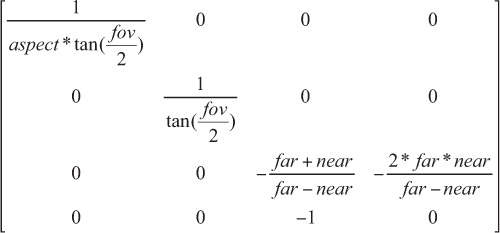

| VertexPositionInputs | Space | AKA | 타입 | 설명 |
|---|
| positionOS | Object | Local / Model | float3 | |
| positionWS | World | Global | float3 | |
| positionVS | View | Camera / Eye | float3 | 카메라에서 바라볼때 |
| positionCS | Clip (Homogeneous) | | float4 | [-w, w] 카메라 시야에서 안보인 것은 제외, Orthogonal 적용 |
| positionNDC | Normalized Device Coordinate (Homogeneous) | | float4 | [0, w] : (x, y, z, w) |
- 동차좌표 homogeneous coordinate
- 동차좌표는 n차원의 직교좌표를 n+1차원으로 확장한 것이다
- float3 => float4로 되면서 Homogeneous를 붙임
- Perspective-Correct Interpolation을 위해 Normalized Device Coordinate (Homogeneous)를 사용함.
uint2 positionSS; // Screen space pixel coordinates : [0, NumPixels)
uint2 tileCoord; // Screen tile coordinates : [0, NumTiles)
float deviceDepth; // Depth from the depth buffer : [0, 1] (typically reversed)
float linearDepth; // View space Z coordinate : [Near, Far]
OS ----------------------- Object Space
| UNITY_MATRIX_M * OS
WS ----------------------- World Space
| UNITY_MATRIX_V * WS
VS ----------------------- View Space
| UNITY_MATRIX_P * VS
CS ----------------------- Clip Space (Homogeneous)
| NDC = CS * 0.5
| NDC.x = NDC.x + NDC.w
| NDC.y = NDC.y + NDC.w // DirectX
| NDC.y = -NDC.y + NDC.w // OpenGL
| NDC.zw = CS.zw
NDC ---------------------- Normalized Device Coordinate (Homogeneous) [0..w]
| pd = (NDC.xyz / NDC.w); // [0, 1] : perspective divide
| ndc = pd * 2.0 - 1.0; // [-1, 1]
|
|
ndc ---------------------- Normalized Device Coordinate (Nonhomogeneous) [-1..1]
| float2 uv_Screen = positionNDC.xy / positionNDC.w;
| float2 uv_Screen = GetNormalizedScreenSpaceUV(positionCS);
uv_Screen ---------------- [0, 1]
| float2 positionScreen = uv_Screen * _ScreenParams.xy;
positionScreen ----------- [0, screenWidth] / [0, screenHeight]
- com.unity.render-pipelines.core/ShaderLibrary/SpaceTransforms.hlsl
---
title: Positions
---
flowchart LR
ObjectPos --TransformObjectToWorld--> WorldPos
ObjectPos --TransformObjectToHClip--> HClipPos
WorldPos --TransformWorldToObject--> ObjectPos
WorldPos --TransformWorldToView--> ViewPos
WorldPos --TransformWorldToHClip--> HClipPos
ViewPos --TransformViewToWorld--> WorldPos
ViewPos --TransformWViewToHClip--> HClipPos
---
title: Directions
---
flowchart LR
ObjectDir --TransformObjectToTangent--> TangentDir
ObjectDir --TransformObjectToWorldDir--> WorldDir
TangentDir --TransformTangentToObject--> ObjectDir
TangentDir --TransformTangentToWorldDir --> WorldDir
WorldDir --TransformWorldToTangentDir--> TangentDir
WorldDir --TransformWorldToObjectDir--> ObjectDir
WorldDir --TransformWorldToViewDir--> ViewDir
WorldDir --TransformWorldToHClipDir--> HClipDir
ViewDir --TransformViewToWorldDir--> WorldDir
---
title: Surface Normals
---
flowchart LR
ObjectNormal --TransformObjectToWorldNormal--> WorldNormal
WorldNormal --TransformWorldToViewNormal--> ViewNormal
WorldNormal --TransformWorldToTangent--> TangentNormal
WorldNormal --TransformWorldToObjectNormal--> ObjectNormal
ViewNormal --TransformViewToWorldNormal--> WorldNormal
TangentNormal --TransformTangentToWorld --> WorldNormal
| Matrix | 설명 |
|---|
| UNITY_MATRIX_M | renderer.localToWorldMatrix |
| UNITY_MATRIX_V | camera.worldToCameraMatrix |
| UNITY_MATRIX_P | GL.GetGPUProjectionMatrix(camera.projectionMatrix, false); |
- localToWorldMatrix
- 유니티 4까지는 GPU에 넘겨주기전에 스케일을 가공하여
- renderer.localToWorldMatrix, transform.localToWorldMatrix가 달랐으나 지금은 같음.
| 카메라 관련 | 렌더링(UNITY_MATRIX_)의 뷰 전방은 -z. 카메라 행렬은 에디터와 동일하게 +z를 앞으로 사용 |
|---|
| UNITY_MATRIX_V | cam.worldToCameraMatrix |
| UNITY_MATRIX_P | GL.GetGPUProjectionMatrix(camera.projectionMatrix, false) |
| UNITY_MATRIX_I_V | cam.cameraToWorldMatrix |
| UNITY_MATRIX_I_P | GL.GetGPUProjectionMatrix(camera.projectionMatrix, false).inverse |
| unity_WorldToCamera | Matrix4x4(cam.transform.position, cam.transform.rotation, Vector3.one) |
| unity_CameraToWorld | Matrix4x4(cam.transform.position, cam.transform.rotation, Vector3.one).inverse |
| unity_CameraProjection | cam.projectionMatrix |
| unity_CameraInvProjection | cam.projectionMatrix.inverse |
| _ProjectionParams | x | y | z | w |
|---|
| DirectX | 1 | near plane | far plane | 1 / farplane |
| OpenGL | -1 | near plane | far plane | 1 / farplane |
| UNITY_REVERSED_Z | UNITY_NEAR_CLIP_VALUE | UNITY_RAW_FAR_CLIP_VALUE |
|---|
| DirectX | 1 | 1 | 0 |
| Vulkan | 1 | 1 | 0 |
| OpenGL | 0 | -1 | 1 |

// Find our current location in the camera's projection space.
Vector3 pt = Camera.main.projectionMatrix.MultiplyPoint(transform.position);
// Matrix4x4.MultiplyPoint
public Vector3 MultiplyPoint(Matrix4x4 mat, Vector3 v)
{
Vector3 result;
result.x = mat.m00 * v.x + mat.m01 * v.y + mat.m02 * v.z + mat.m03;
result.y = mat.m10 * v.x + mat.m11 * v.y + mat.m12 * v.z + mat.m13;
result.z = mat.m20 * v.x + mat.m21 * v.y + mat.m22 * v.z + mat.m23;
float num = mat.m30 * v.x + mat.m31 * v.y + mat.m32 * v.z + mat.m33;
num = 1 / num;
result.x *= num;
result.y *= num;
result.z *= num;
return result;
}
// z값 구하지 않으면
public Vector3 MultiplyPoint(Matrix4x4 mat, Vector3 v)
{
Vector3 result;
result.x = mat.m00 * v.x + mat.m01 * v.y + mat.m02 * v.z + mat.m03;
result.y = mat.m10 * v.x + mat.m11 * v.y + mat.m12 * v.z + mat.m13;
float num = mat.m30 * v.x + mat.m31 * v.y + mat.m32 * v.z + mat.m33;
num = 1 / num;
result.x *= num;
result.y *= num;
return result;
}
// 값을 대입하면
public Vector3 MultiplyPoint(Matrix4x4 mat, Vector3 v)
{
Vector3 result;
result.x = mat.m00 * v.x + 0 * v.y + 0 * v.z + 0;
result.y = 0 * v.x + mat.m11 * v.y + 0 * v.z + 0;
float num = 0 * v.x + 0 * v.y + -1 * v.z + 0;
num = 1 / num;
result.x *= num;
result.y *= num;
return result;
}
// 최종적으로
public Vector3 MultiplyPoint(Matrix4x4 mat, Vector3 v)
{
Vector3 result;
result.x = mat.m00 * v.x;
result.y = mat.m11 * v.y;
float num = -1 * v.z;
num = 1 / num;
result.x *= num;
result.y *= num;
return result;
}
(X, Y, linearEyeDepth)
positionNDC // [-1, 1]
X = positionNDC.x * linearEyeDepth / mat.m00
Y = positionNDC.x * linearEyeDepth / mat.m11
The zero-based row-column position:
| _m00, _m01, _m02, _m03 |
| _m10, _m11, _m12, _m13 |
| _m20, _m21, _m22, _m23 |
| _m30, _m31, _m32, _m33 |
The one-based row-column position:
| _11, _12, _13, _14 |
| _21, _22, _23, _24 |
| _31, _32, _33, _34 |
| _41, _42, _43, _44 |
- texel(
TExture + piXEL) coordinate
Direct X
(0,0) (1,0)
+-------+-------+
| | |
| | |
+-------+-------+
| | |
| | |
+-------+-------+
(0,1) (1,1)
OpenGL / UnityEngine
(0,1) (1,1)
+-------+-------+
| | |
| | |
+-------+-------+
| | |
| | |
+-------+-------+
(0,0) (1,0)
- 수학적으로 바라보면 모든 2D좌표계를 OpenGL방식으로하면 좌표계를 헷갈릴 걱정이 없다. 하지만, 프로그래밍 하는 입장에서는 DirectX방식이 좀 더 와닿을 것이다.


